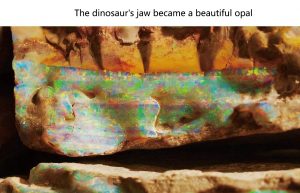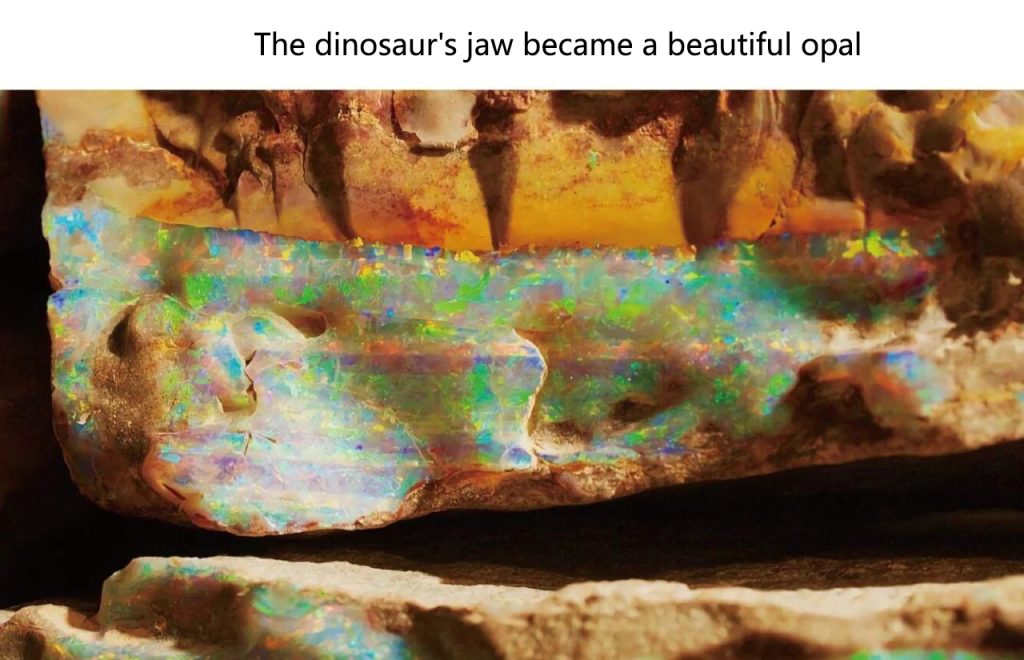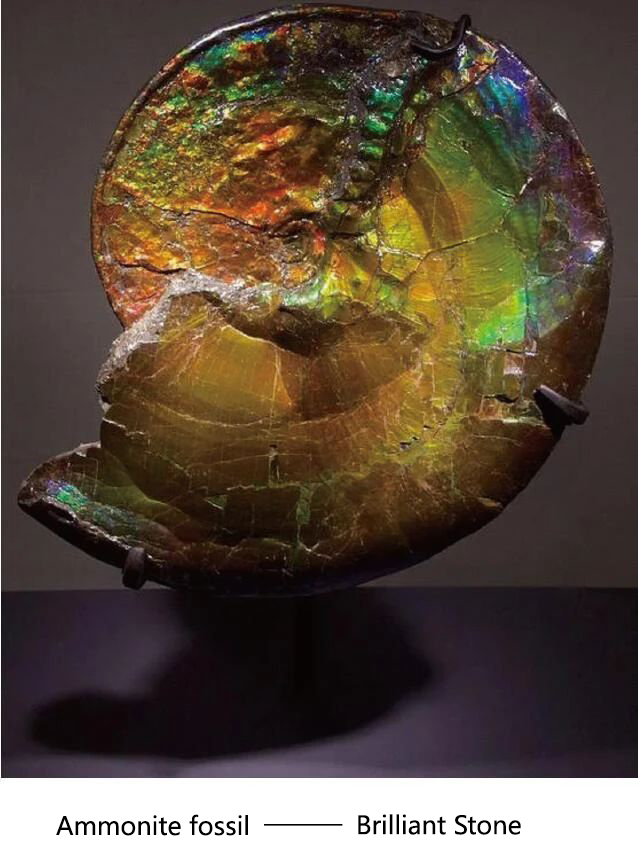
Speaking of fossils, the first thing you think of is the gray stone, right? But in fact, some fossils have richer colors than rainbows.
Colorful “fish scale” zebra stone
BanCai stone is a very beautiful stone. Picking up a colorful stone and turning it under the light, you can see a variety of brilliant colors such as green, red, golden yellow and blue. Its beauty even reaches the gem level. Welcomed by ladies who love beauty. You must have never imagined that such a beautiful brindle stone is actually a fossil of an ammonite, a mollusk that has lived on the earth for 350 million years.
Ammonites appeared in the early Devonian and became extinct together with the dinosaurs at the end of the Cretaceous. Ammonites and Nautilus are close relatives, they both rely on head “muscles” to swim. When th
e ammonite first appeared, the species in the primitive ocean were still small invertebrates with weak locomotion ability, and there were not many competitors. At that time, ammonites usually carried a heavy hard shell and swim leisurely in the sea. Move.
But slowly, there were more and more types of marine animals. By the end of the Cretaceous, most of the species had swimed much faster than ammonites. Various fish and octopus (octopus, squid) animals divided the ammonites. Food. In order to live better and longer, ammonites continue to evolve to adapt to changing environments, and changing the hard shell is their strategy of choice.

The shell of ammonite is gradually bent as the environment changes. Studies believe that ammonites evolved from hornstone mollusks. The shells of hornstones are straight.
After evolving into ammonites, the shell becomes curved, and the number of turns increases over time. The shell is “bent” in order to increase the speed of movement. Studies have shown that as the number of circling turns of the shell increases, the swimming speed is also increasing.
Not only does the shell become more and more curved, the compartments also gradually increase. The shell of ammonites gets bigger with age. The first shell of a newly born small ammonite is called the original shell.
As the ammonite grows up, the inner soft body continuously secretes new shells forward. The shell and the shell are separated by a piece of next wall to form a shell. One by one compartment.
Ammonites can be filled with air and water in these compartments to control the ups and downs. The principle is similar to that of a submarine. When there is only gas in the compartment, the ammonite will float on the sea. If 20% of the volume of sea water is loaded in the compartment, the ammonite can be suspended in the sea.
The shell of the late ammonites also became thinner and thinner, and the ammonites after the “burden reduction” had a faster swimming speed than their predecessors-the final cake ammonite was considered the champion of the ammonite swimming competition.
Of course, compared with fish and octopus that are good at swimming, the fastest ammonite has no competitive advantage in speed. Therefore, when the asteroid hits the earth, and the life on the earth is “lack of clothing and wearing” for a long time, the ammonite finally did not compete with other marine life and went extinct. However, although the change of the shell did not succeed in saving the ammonite, it has left the earth with a dazzling gemstone—briefite.
The main components of ammonite shells are aragonite and calcite. The chemical components of these two minerals are calcium carbonate. Due to the different arrangement of atoms, different minerals are formed, and the effects of light refracting are also different.
The crystals of aragonite are arranged in parallel, and when light is irradiated, they will be reflected layer by layer, and the interference between these reflected lights will show the colorful color of the colorful stone.
In addition, the thickness of the shell secreted by ammonites varies in different periods. The thicker the shell, the easier it is to form a red color change; the thinner the shell, the easier it is to form a blue to purple color change.
Because the aragonite layer of the cake ammonite is very thin, only 0.5-0.8 mm thick, the refracted light can be clearly presented, and such a thin layer of aragonite is also very easy to crack during the formation of the fossil.
The last thing we see is the spiral-shaped colorful motley stone that is “divided” into slices of fish scales. This beautiful and fragile gemstone will become a weapon to embellish the beautiful faces of ladies after being transformed by the craftsmen.
Colorful “spots” Opal
Opal is also a colorful and beautiful stone. It has various “color spots” such as red, orange, yellow, green, blue, and purple. People call it “God’s oil painting” in order to appreciate its gorgeousness and colorfulness. In this “oil painting”, sometimes the “sound and smile” of ancient animals and plants are depicted.
Under the action of high temperature and high pressure, the rocks and gravel melted into a silica solution. The silica solution flows like magma into the cracks about 40 meters below the surface and has been cooled for about one to two million years.
The silica solution began to solidify slowly, and finally “reborn from the fire”, from ordinary stone to beautiful opal. The sedimentation process is also quite long. The thickness of the sediment will increase by one centimeter every 5 million years.
In this process, the silica solution may cover the remains of various animals and plants or penetrate into the crevices. Covered by it, the Opper that was eventually formed became fossils of animals and plants.
Animals infiltrated by silica include the famous dinosaurs. Miners discovered the remains of a dinosaur named Vevalasaurus, a rare dinosaur fossil containing jaws and teeth, near the Oper’s Vevala mine near Lightning Ridge, an inland town in Australia.
Moreover, this dinosaur’s right lower jaw once had some silica solution “invaded”, and now it has become the world’s first “rainbow” chin, the trendy “Dalong”. People can go to the Australian Opal Centre Museum to see its style.

In addition to the dinosaurs, another animal that had undergone “Oper Plastic Surgery” was found in this mining area, and that is the hard-toothed platypus, the ancestor of the modern platypus.
With the help of Opal, the cheekbones of this hard-toothed platypus showed a faint milky pearl luster, which is the skin color that Asian women dream of.
In the Wevala mining area, the silica solution also covered many plant remains, forming a large number of fragmented plant fossil opals. Plant fossil opals are mainly tree bark, seeds, and nuts. Most of them are opals with black or white background without color change.
But there are also a few precious opals that have gorgeous and rich color-changing effects and retain more internal details of plants. These can be seen in Australian museums.
The reason why Opal has such a colorful color is because of its special structure, which is a large three-dimensional structure formed by closely packing tiny silica spheres.
Light is diffracted in the tiny gaps between the spheres, and at the same time, interference occurs between the layers of the spheres, and is separated into light of various wavelengths, and we see a variety of colors.
The color produced by Opal is related to the diameter of the silica sphere. The blue-green color changes between 160 and 220 nanometers, the red to blue color changes between 220 and 360 nanometers, and the color changes between 370 and 460 nanometers. Red color changes appear between them, and these color changes appear as patches of color.
Fossil Opal is not only a major “Optimus Prime” in the gem world, it is also of great help to the research of geology and paleontology.
“Flowers” blooming with fossil jade
Colored fossil jade is an organic gem from the deep sea. On a black or red background, there are blooming flowers of various forms of “chrysanthemums”, either radially or curled, or clusters of flowers, or lonely fragrant… …The colors of fossil jade are colorful, and it is a rare collectible treasure.
As the name suggests, colored fossil jade is also a kind of fossil, and the predecessor of “chrysanthemum” is actually a variety of ancient marine creatures.
Because of the geographical advantage, the western region of China is the producing area of the best quality colored fossil jade. 436 million years ago, western China began to uplift from shallow seas to land and then to plateau during violent crustal movements such as volcanic eruptions, during which all ancient marine life in a large area of the sea was buried by sudden volcanoes.
The remains of ancient marine life such as crinoline stems, corals, sea urchins, moss, layer foraminifera, and brachiopods formed fossils after long-term deposition, geothermal grilling, and orogenic extrusion.
During this period, a large amount of silica solution was produced due to high temperature and high pressure for a long time. The solution penetrated into some fossils to form gems called colored fossil jade.
However, in addition to western China, fossil jade can also be found in places where geological changes have occurred throughout the world.
Coral jade is the most discovered and the earliest fossil jade to enter the commodity market. It is favored by consumers because of its beautiful appearance.
After the submarine volcano erupted, a lot of volcanic ash was produced, which brought abundant macro elements (such as colored elements iron, copper, manganese, etc. and colorless elements magnesium, potassium, sodium, etc.) and trace elements (such as zinc, chromium, nickel, etc.) to the ocean. ). Corals absorb various elements in the water during their growth process to create hard calcareous bones-corals. Corals form coral rocks after petrification. Different types of corals absorb different types of elements.
If the corals mainly adsorb iron, the color of the coral stone will be red; if the corals mainly adsorb magnesium and have a little iron, the color of the coral stone will be pink. Or powdery white; if it absorbs magnesium, the color of coral stone is white; it absorbs copper as green, and absorbs manganese as black; and so on.
After hundreds of millions of years of long and complicated crustal activities, some silicon elements have been infiltrated into the coral stones, forming colorful coral jade. Currently, Taiwan, China is the largest producer of coral jade.

Crinoid is one of the oldest animals on the planet, having lived for 500 million years. In 230 million years ago, crinoids grew everywhere in the ocean, so once geological movement occurred, crinoids were easily buried in the stratum to form fossils. Sea lily looks like a plant.
It absorbs calcium from the ocean and grows long stems to root on the bottom of the sea. Then it opens a large flower-like mouth to face the water and waits for food to “automatically” come to the door. After the death of crinoids, these calcareous calyxes are not easily decomposed by microorganisms, and then preserved as fossils.
Due to the disturbance of seawater, these stems and calyxes often cannot preserve the shape of the entire “flower” during the lifetime, but will be scattered into small circles or five-pointed stars to gather on the surface of the fossil.
The main component of crinoid fossils is single crystal calcite, usually white, sometimes mixed with ferric ions, showing a bright red color, which is very beautiful against the blue-gray surrounding rock. In addition to making jewelry, large pieces of fossil jade can also be made into teapots, cups, vases, and even furniture such as tables and chairs.
Fossils are not all gray, rainbow-colored fossils can even replace artificial gems and building materials, decorating people’s colorful lives.
Comments